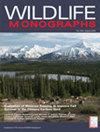The piping plover (Charadrius melodus) was listed under the United States Endangered Species Act (ESA) because of habitat loss and excessive predation. The Missouri River provides important habitat for the Great Plains population of the species, some of which nest and forage on river sandbars deposited naturally during high river flows. The United States Army Corps of Engineers (USACE) operates a series of dams on the river that affect water level and the size, number, distribution, and vegetative cover of these sandbars. As a federal agency, USACE is required by the ESA to have a program to conserve the piping plover, and is prohibited from engaging in activities that jeopardize the plover's continued existence. Pursuant to these obligations, the USACE implemented a habitat creation program on the Gavins Point Reach (GVP) and Lewis and Clark Lake (LCL) on the Missouri River from 2004 to 2011. This habitat creation provided an opportunity to study the piping plover's demographic response to several habitat types, and in particular to habitat creation. The goal of this study was to assess the effects of management on plovers using the Missouri River. We studied the changes in engineered and natural habitats, and compared the effects of newly engineered habitat versus naturally created habitat on plover demography during 2005–2011. To this end, we estimated changes in nesting habitat (open or sparsely vegetated dry sand) and examined the factors affecting nest success, chick survival from hatching to fledging, survival, and movement (between and among engineered and natural sandbars) of hatch-year and adult birds, fidelity of plovers to the study area, and immigration of plovers into engineered habitat. We used demographic estimates to determine overall and habitat-specific reproductive output and overall population growth rate. Under the assumption that plovers are habitat limited on the Missouri River, we predicted that they would respond positively to the creation of engineered habitat, that their demographic rates would be higher at those sites than on older, natural sandbars, and that over time, the rates would resemble those on older, natural habitats. Engineered sandbars had proportionally more plover nesting habitat than natural sandbars, but the proportion of nesting habitat decreased through vegetation encroachment and erosion as the sandbars aged. Adult and hatch-year plovers immigrated to engineered sandbars, but immigration slowed as nesting density increased. Nesting density on engineered sandbars increased soon after sandbar construction, peaked 2–3 years later, and then declined to levels similar to those on older, natural sandbars. Birds that nested on engineered sandbars had higher nest success, and those nesting on LCL had higher chick survival than those that nested on GVP sandbars. Adult survival did not differ between engineered or natural habitat, but apparent survival was lower for birds that were not known to nest, indicating higher emigration or mortality rates for non-nesters. Adult and hatch-year plovers had high fidelity to the study area (>60% for hatch-year birds, >90% for adults), and hatch-year fidelity was highest (>80%) when habitat availability increased. We estimated that given observed survival rates, the reproductive output needed for a stationary population was 1.25 chicks fledged per pair, a rate which was equaled or exceeded in 3 of 4 years on LCL, in 2 of 5 years on engineered sandbars on GVP, and in 1 of 5 years on natural sandbars on GVP. Our results support the hypothesis that piping plovers were habitat-limited before and during the study. Although nest exclosure and predator control sometimes can improve reproductive output, we predict that these interventions will do little to increase population size unless there is additional habitat to capture enhanced productivity. Based on high fidelity rates and short distances between subsequent nesting attempts (median = 12 km for adults), we suggest that habitat construction be widely distributed within approximately 12 km of a source population to maximize the efficiency of the population-building process. © 2015 The Wildlife Society.


